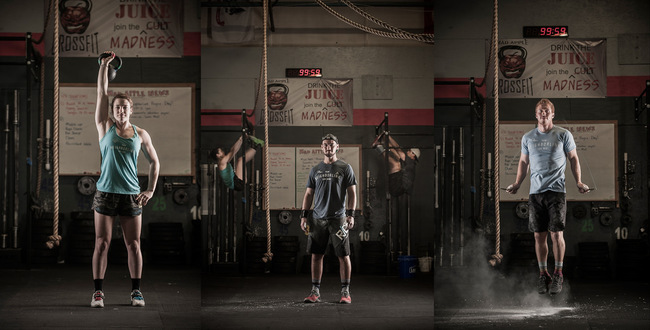|
Are you tired of ordinary cardio exercises? Fueled by endurance running plateaus and supported by evidence, a new type of training emerged: high intensity interval training (HIIT). HIIT can be a complimentary exercise for those who dread cardio workouts, want to improve their success in endurance events, or only have time for a short workout. The Science Behind The Phenomenon High intensity interval training (HIIT) is defined as “brief to moderate duration intervals with high intensity (above anaerobic threshold) separated by brief periods of low intensity exercise or rest to allow for some but not full recovery.” For example, instead of jogging for 45 minutes at a steady pace, a standard HIIT session involves sprinting for 30 seconds, then lightly jogging for 1 minute, before repeating the sprint for a total of 15 minutes. The time frame is considerably shorter, but the aerobic workload is comparable. A 2008 study by Gibala et al proved 2.5 hours of sprint interval training produced similar biochemical muscle changes to 10.5 hours of endurance training and similar endurance performance benefits.  Success with HIIT revolves around the ability to exceed your anaerobic threshold - the point at which lactic acid begins to accumulate in the bloodstream. Consistently training at high intensities, such as during HIIT, improves your anaerobic threshold. When you improve your anaerobic threshold, you train the body to recycle lactic acid allowing you to work harder, for longer. This translates to improved aerobic endurance by improving the ability to buffer lactic acid over the long term. Other than improved training performance for both aerobic and anaerobic activities, HIIT training has been shown to increase resting metabolic rate (King 2010). For the weight conscious adult, this means that you will residually burn more calories following a workout. In 2010, Dr. Nybo concluded “SIT [HIIT] may induce similar improvements in cardiorespiratory fitness and skeletal muscle oxidative capacity as prolonged training.” This suggests that the same benefits seen in extended training times could be replaced by HIIT style workouts. Apply High Intensity Interval Training Today! Is this method practical for the general population? As a health care practitioners, we do not typically release people to exercise at maximal intensities unless they are cleared from medical care. Our recommendation is to perform interval training to YOUR level of intensity. Instead of training at 90-100% of your capabilities, scale down the intensity interval to 80% of your maximal output. Then next time push your body and intervals a little further. Remember, we use HIIT to challenge our cardio system, improve endurance results, and maximize efficiency under time constraints. High intensity interval training can be performed with any type of exercise: running, on the elliptical, or with circuit training. Incorporating different variations like HIIT into your workout routine is a simple way to challenge the body to help you reach your fitness goals. References:
1. Gibala, Martin J; Jonathan P. Little, Martin van Essen, Geoffrey P. Wilkin, Kirsten A. Burgomaster, Adeel Safdar, Sandeep Raha and Mark A. Tarnopolsky (September 15, 2006) 2. King, Jeffrey W. A Comparison of the Effects of Interval Training vs. Continuous Training on Weight Loss and Body Composition in Obese Pre-Menopausal Women (M.A. thesis). East Tennessee State University. 3. Laursen, P.B. and Jenkins, D.G. (2002b) The scientific basis for high- intensity interval training: optimizing training programs and maximizing performance in highly trained endurance athletes. Sports Medicine 32(1), 53-73 4. Nybo, Lars, Emil Sundstrup, Markus D. Jakobsen, Magni Mohr, Therese Hornstrup, Lene Simonsen, Jens Bülow, Morten B. Randers, Jens J. Nielsen, Per Aagaard, and Peter Krustrup. "High-Intensity Training versus Traditional Exercise Interventions for Promoting Health." Medicine & Science in Sports & Exercise 42.10 (2010): 1951-958. Web. <http://www.ncbi.nlm.nih.gov/pubmed/20195181>.
2 Comments
Manuel Franco
8/29/2023 10:52:05 pm
I just want to say Thank You to everyone who supported me through the years. My name is Manuel Franco, New Berlin, Wisconsin. My story of how I won the Powerball lottery of $768.4M is a bit of a tale. I have been playing Powerball tickets for 6 years now since I turned 18. I bought my first ticket on my 18 birthday. I was feeling very lucky that day because I had contacted Dr. Odunga Michael to help me with the winning Powerball numbers. I really had that great great feeling that I looked at the camera wanting to wink at it. I only did a tiny part of it and trusted him. He gave me the numbers after I played a couple other tickets along with it for $10. I checked my ticket after the winnings came online and saw the numbers were correct including the Power play. I screamed for about 10 minutes because it felt like a dream. I had won $768.4M. You can check my winning testimony with the lottery officials just with my name search. Thank you Dr Odunga. Well, his email is [email protected] and you can also call or Whats-app him at +2348167159012 so you guys can contact him
Reply
Hailey Garcia
6/20/2024 11:09:28 pm
My name is Hailey Garcia and I am from New Jersey. My herpes virus turned to war after 2 years of living with it. I have tried different medical procedures to cure my herpes but to no avail. Most people think herpes is only a minor skin irritation of which herpes has long term effects on health and passes through the bloodstream and can be easily contracted through sexual intercourse. I knew I had herpes from the first day I started feeling itchy in my pubic area and the pain was very unbearable. I couldn't stand it anymore. After 2 years of trying other means to get rid of it, I had to contact Doctor Odunga to help me with a permanent cure. I saw his email and whats-app number from a testimony I read online from a lady who was also helped by him in curing infertility problems, I had faith and contacted him. He assured me of his work and I ordered his herbal medicine. Within 5 days, I didn't feel any pain anymore and within 2 weeks, my skin was all cleared and smooth. I am very grateful to you sir and I write this testimony as others have done to bring those having faith to you sir. If you have herpes or other similar disease and you want it cured, kindly contact Doctor Odunga, Whats-App (wa.me/+2348167159012) OR Email [email protected]
Reply
Leave a Reply. |
Heafner HealthPhysical Therapy Archives
April 2024
Categories |



 RSS Feed
RSS Feed
